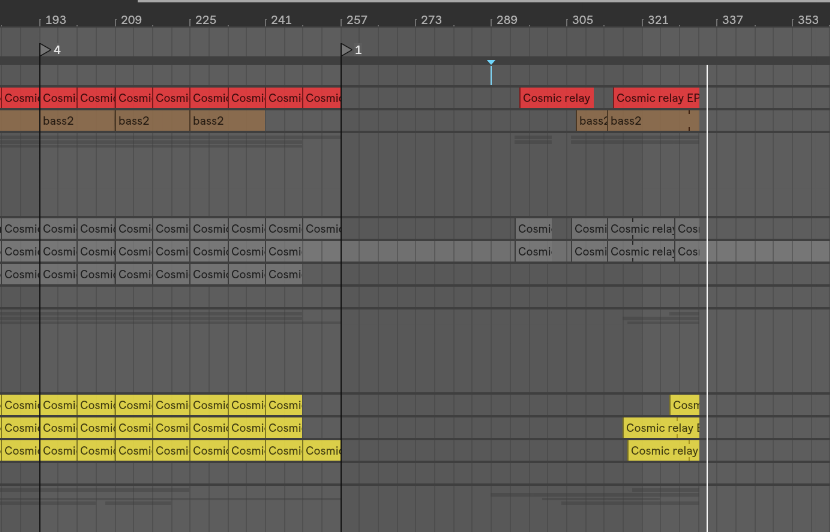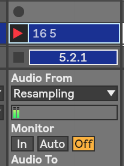Exploring Electronic Musician’s Mindsets
As I write this, I’m in the middle of the second edition of my Catalyst program, a four-week training designed for musicians. It’s not just about the technical side of producing electronic music—it’s about taking a step back and looking at the bigger picture. People often hear a finished song and get lost in it, but rarely do they consider the invisible journey that led there: the hours of trial and error, the frustrations, the bursts of inspiration, and the countless decisions made along the way.
Music-making isn’t just about pressing buttons or arranging notes; it’s about navigating the mental states that shape every step of the process. Sitting down at a computer and starting a session isn’t a straightforward task—it’s a dance between energy, intention, and mindset. Some days, ideas pour out effortlessly. Other days, everything feels like a struggle. What fascinates me is not only the technical side of things, but also the mental choreography that makes a session successful.
Over time, I’ve realized that what I actually teach isn’t only about sound design, mixing, or composition—it’s also about knowing yourself. The better you understand your own working patterns, the more you can prepare, direct, and ultimately enjoy your sessions. My personal way of making music isn’t a formula that will work for everyone, but the principle behind it—that music creation is non-linear, circular, and iterative—applies universally.
In fact, one of the biggest surprises for the people I coach is how often the problems they think are technical are actually mental. For example, many producers complain about sound quality. Yes, sometimes it’s about EQ or compression—but often, the real issue is a mindset mismatch. They’re approaching the problem with the wrong mental framework. This misunderstanding is so common that I decided to build an entire training around it—and now, this post.
What is a mindset?
A mindset is the lens through which we perceive, interpret, and interact with the world. In psychology, it’s often described as a framework of assumptions, beliefs, and attitudes that shape our behavior. In music, a mindset is the mental stance you adopt when you enter the studio.
It could be the curiosity of an Explorer, the discipline of a Wrapper, or the playfulness of the Fun Zone. Each mindset changes how you act, what you notice, and how you respond to challenges. Importantly, mindsets are not permanent—they’re modes. You can learn to recognize them and choose which one you want to inhabit. Doing so gives you a tremendous amount of freedom. Instead of unconsciously drifting into frustration or distraction, you can intentionally set the stage for creativity.
Think of a mindset like a filter. If you walk into the studio with the “critic” filter on, every sound feels inadequate. If you walk in with the “explorer” filter, even mistakes feel like discoveries. The activity might be the same—pressing keys, twisting knobs—but the outcome, and more importantly, how you feel about it, is entirely different.
My experience with writer’s block

Electronic music producer reflecting on creative mindset
Earlier this year, I went through a period of writer’s block. This isn’t unusual for me—it happens a few times a year—but this time, I chose to observe it closely instead of resisting it. I asked myself a few key questions:
-
What am I trying to achieve?
-
How am I approaching it?
-
What thoughts are dominating my headspace?
-
How am I feeling in this moment?
This reflection led me to realize something: electronic music almost encourages multitasking. Think about it—you might start by writing a hook, then jump into beat programming, then tweak the sound design, and suddenly you’re back to doubting the hook because of how the sound interacts with the rhythm. The cycle repeats, and hours later you feel like you’ve gone in circles.
This multitasking loop is maddening, and worse, it often disguises itself as “productive work.” In reality, it fragments attention and leads to creative fatigue. On top of this, many musicians tie their sense of validation to outcomes: finishing a track, releasing it, getting it signed. This creates layers of pressure that block creativity even further.
To break out of it, I tried something deceptively simple: before opening my DAW, I took pen and paper and wrote down what I wanted to do. Sometimes I added which mindset I tried to adopt for the session. Just 20–30 minutes of focused intention made a huge difference.
I encouraged a client of mine to try the same. At first, he resisted. But when he finally gave it a chance, he came back a week later looking almost transformed. He said it had not only improved his productivity but also given him clarity. What mattered most was the act of choosing a mindset. That realization became a turning point in my life.
Common Mindsets in Music Making
Through weeks of self-tracking and reflection, I identified recurring modes of operation—mindsets that I and many of my clients fall into. Naming them has proven powerful because it gives us language to recognize where we are and adjust if needed.
Below are the most common ones I work with.
1. The Explorer
This mode is pretty much the most common one for me. Someone lately was asking me how much time I spend working on the track when in the studio, and I replied that most of my time was about testing concepts. The Explorer Mindset is all about not necessarily trying to achieve anything, but testing, understanding, and practicing something that is either new or not fully integrated. The explorer is not trying to make a song or to make something “cool”, but instead, it’s about preparing things that will be useful for sessions where we are hunting for new ideas. If you don’t explore, you’ll be stuck in repeating yourself or formulas that have worked for you in the past. Perhaps it’s not a problem but down the road, you might have several songs that are all the same, but with a little variation.
-
Practical example: Experimenting with a new synth plugin without worrying about saving presets.
-
Recognition tip: You feel playful and interested in “what if” questions.
-
Best use: Early in the creative cycle, or when you feel stuck in repetitive habits.
Motivation: Acquiring new ideas.
Pitfall: Getting lost in endless tinkering without finishing anything.
The Explorer mindset reminds us that not every session needs to be productive in a traditional sense. Sometimes, the value is in simply showing up to discover something new. Explorers fill sketchbooks, not galleries. And those sketches later become the foundation for great works.
2. Innovation
This is similar to the explorer but with a different angle. It’s about understanding a technique, a tool, or a principle and making it your own or improving it. For example, perhaps you’ve been using compression in the same way but now you want to enhance your understanding of compression vs expander to give your music more dynamic range. When in innovation mode, you solely focus on completely immersing yourself into mastering a concept by rehearsing, reading about it, and understanding it. The innovation mindset can also be about working on a song and trying to bring something new to a genre or a specific recurrent sound.
-
Practical example: Using granular synthesis in an unconventional way to reshape a vocal.
-
Recognition tip: You’re asking, “How can I make this mine?”
-
Best use: When you’re ready to push beyond formulas or evolve your style.
Motivation: Expanding your comfort zone and bringing something fresh.
Pitfall: Risk of creating results that sound odd or unpolished before the concept matures.
Innovation requires bravery. It’s where genres are born, but also where many half-finished ideas live. The key is to pair Innovation with other mindsets—especially Wrapping—so that your experiments don’t stay in the sketch folder forever.
3. Replicating
This is the opposite of innovation. Trying to replicate a genre, a song or a technique is about grasping its essence to be able to be part of a community or specific genre (eg. Label perhaps?). Quite often, clients of mine are reluctant to go that path because they feel like they’re copying someone else. I like to tell them that when someone is learning the guitar or an instrument, they always start by learning a song and rehearsing it. That is the replicator mindset. It’s about understanding the fundamentals and being able to redo it. See it as trying a specific dish recipe. It’s a mindset that typically precedes innovation.
-
Practical example: Rebuilding a favourite track in your DAW to study its structure.
-
Recognition tip: You feel like a student, studying patterns and fundamentals.
-
Best use: When learning a new style, or when inspiration feels distant.
Motivation: Understanding the DNA of a genre or track.
Pitfall: Getting too comfortable and never moving beyond imitation.
Replication teaches us humility. It’s not glamorous, but it sharpens the ear and hand. And often, the act of imitation plants seeds of originality, because once you understand the skeleton of a track, you can start bending it into your own shape.
4. Following
When going down that path, you’re following the rules and conventions of “what works,” and while you’re not creating a cover of a special song, we could agree that you’re making a cousin of it. See it like making Reggae, disco, house or generic hip hop. You know what works, you use all the tricks of what is currently in trend and deliver a song that can fit a playlist of that genre. Someone could, for instance, be going in that direction when you have to provide an EP for a label you respect or perhaps preparing for a set in a critical context. See this as a nice follow-up stage from replicating.
-
Practical example: Producing a deep house track using known groove and chord structures.
-
Recognition tip: You feel guided by tradition and trends.
-
Best use: When working on tracks meant for labels, playlists, or live sets in a defined genre.
Motivation: Belonging to a community and delivering recognizable material.
Pitfall: Lack of originality.
Following is often looked down on, but it has value. Communities need songs that “fit.” Playlists need tracks that hold their vibe. It’s not about being a copycat; it’s about contributing to a collective energy. The trick is to know when to follow, and when to step out.
5. Troubleshooting
Perhaps you’ve been working on multiple sessions of recording, sound design, or possibly making songs, and at one point, something is not right. Adopting the troubleshooter mindset means that you’ll fully dedicate your time to fixing problems. This means that your session might not be entirely musical, as you’ll have to find perhaps solutions to something you don’t know. Many musicians will push back their issues until later in the process, and by the end, a song is near completion, an accumulation of problems has piled up, compromising the song’s final outcome. This is particularly true for mixing. Some people wait at the end for mixing, while you can implement habits right from the beginning.
-
Practical example: Spending a session fixing phase issues in your bass and kick relationship.
-
Recognition tip: You feel restless until the problem is solved.
-
Best use: Whenever small issues pile up and start blocking progress.
Motivation: Removing irritants so creativity can flow again.
Pitfall: Getting overwhelmed when solutions aren’t clear.
Troubleshooting is like cleaning your workshop. It’s not glamorous, but without it, you’ll never get anywhere. The secret is to treat troubleshooting as its own mindset, not as an afterthought.
6. Fun Zone
There’s a phase of music production that I call ‘Sandboxing’ or ‘Playground,’ which is when you go to the studio with the sole motivation to have fun. Whatever is fun should occupy your time when here, no rules, no limitations and perhaps no precise goal as well. The Fun Zone is usually the motor of creativity. Recording everything usually will provide material for potential songs. Having ideas coming from spontaneity usually feels authentic.
-
Practical example: Sampling random sounds around your house just because it feels fun.
-
Recognition tip: You’re smiling, moving, or losing track of time.
-
Best use: To recharge creativity or break out of a rut.
Motivation: Joy, spontaneity, and authenticity.
Pitfall: Accidentally imposing rules or expectations and killing the vibe.
The Fun Zone is sacred. It’s where authenticity lives. Many producers lose it over time because they burden every session with expectations. Reclaiming the Fun Zone is often what reignites their love for music.
7. Inspector
This process is designed explicitly for revising material from any project or session. There are 2 sub-modes, though: critic or scout. I would playfully refer to the left-right brain stereotypes, where the left is more analytical and the right is more creative. So when being the critic, you’re on the lookout to validate what you have, while the scout is about spotting unused material and ideas. The only “rule” here is to be either one mode or the other. You can’t be a scout and inspect at the same time; it just doesn’t work.
-
Critic: Evaluating what’s strong and what needs work.
-
Scout: Searching for overlooked gems in old projects.
-
Practical example: Listening to unfinished tracks with fresh ears and marking what stands out.
-
Recognition tip: You’re detached, observing more than creating.
-
Best use: Before sending demos, or when mining past sessions for material.
Motivation: Gaining perspective and harvesting ideas.
Pitfall: Over-criticism that ruins already solid ideas.
Learning to switch between Critic and Scout is powerful. One judges, the other gathers. Doing both at once, however, is a recipe for self-sabotage.
8. Wrapper
If you’re following my non-linear music technique, you know that I like to work on multiple songs simultaneously, which can also lead to procrastination. Finishing a song, which I call wrap-it-up, is a mode that I love and when I pick that one, I feel that things just roll on their own. A key point here is to set a time limit on how much you want to put in the final touches. Because we all know a song is never totally done, setting yourself a deadline is an arbitrary way to put an end to a potential rabbit hole. In this mode, I usually start from the beginning of the song, fix one issue at a time as I g,o until I get to the end. Another trick is to listen to the song once and note on paper all the things you don’t like. But it’s important to limit yourself to one listen; otherwise, you get into a witch-hunt mode and will fix non-existent issues.
-
Practical example: Setting a timer for two hours and committing to exporting the track at the end.
-
Recognition tip: You’re focused on closure rather than exploration.
-
Best use: When you’ve explored, innovated, and refined enough—it’s time to move on.
Motivation: Wrapping up so you can release or shift to the next project.
Pitfall: Endless tweaking or chasing problems that don’t exist.
The Wrapper mindset is liberating because it forces acceptance. No track is ever perfect. The Wrapper knows this—and finishes anyway.
The power of shifting
What changed everything for me was realizing that I could choose these modes. Instead of unconsciously wandering into frustration, I could ask: “What mindset will serve me today?” That one question reframed everything.
Think of it like sports. You can casually shoot hoops for fun, and that’s great. But if you want to improve your game, you don’t just play randomly—you decide whether to focus on shooting, defence, or stamina. Musicians can apply the same principle.
Masterpieces aren’t accidents. They happen when preparation, awareness, and the right mindset come together.
Practical exercises for readers
If you want to start experimenting with mindsets, here are a few things you can try:
-
Pre-session journaling – Before you open your DAW, write down: “Today, my mindset will be ___.” Stick with it for 30 minutes.
-
Post-session reflection – Note what worked, what didn’t, and whether you drifted into another mindset.
-
Mindset rotation – Dedicate different days of the week to different mindsets. For example: Monday = Explorer, Wednesday = Troubleshooter, Friday = Wrapper.
-
Accountability buddy – Share your chosen mindset with a fellow producer. Knowing someone else will ask keeps you intentional.
-
Play with extremes – If you normally only explore, force yourself into Wrapper mode for a week. If you usually replicate, permit yourself to enter the Fun Zone.
In closing
Mindsets are not rules. They’re tools. Each one has strengths and pitfalls. The key is to recognize where you are, decide where you want to be, and use that awareness to steer your process.
If you start tracking your sessions—writing down your intention before you begin, and reflecting afterwards—you’ll start to notice patterns. You’ll see which mindsets you gravitate toward, which ones you avoid, and which ones give you the best results.
Over time, this practice not only improves productivity but also reduces frustration and reconnects you with the joy of music.
So the next time you sit in front of your DAW, ask yourself: What mindset do I want to adopt today? That one small act of intention could be the key to unlocking your best music yet.




